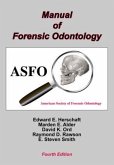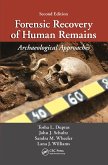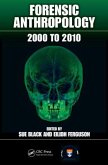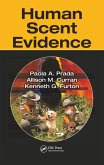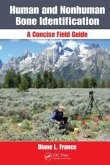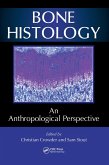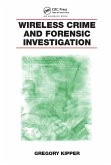Biological Affinity in Forensic Identification of Human Skeletal Remains
Beyond Black and White
Herausgeber: Berg, Gregory E; Ta'ala, Sabrina C
Biological Affinity in Forensic Identification of Human Skeletal Remains
Beyond Black and White
Herausgeber: Berg, Gregory E; Ta'ala, Sabrina C
- Broschiertes Buch
- Merkliste
- Auf die Merkliste
- Bewerten Bewerten
- Teilen
- Produkt teilen
- Produkterinnerung
- Produkterinnerung
Consolidating work done in a variety of studies in recent decades, this book presents a range of tools that can be used to identify the probable socio-cultural "race" category of unknown human remains. It presents equations and examples useful for assessing ancestry with a combination of seven morphoscopic traits and discusses ancestry estimatio
Andere Kunden interessierten sich auch für
![Manual of Forensic Odontology Manual of Forensic Odontology]() Andzrej HuczynskiManual of Forensic Odontology86,99 €
Andzrej HuczynskiManual of Forensic Odontology86,99 €![Forensic Recovery of Human Remains Forensic Recovery of Human Remains]() Tosha L DuprasForensic Recovery of Human Remains82,99 €
Tosha L DuprasForensic Recovery of Human Remains82,99 €![Forensic Anthropology Forensic Anthropology]() Forensic Anthropology152,99 €
Forensic Anthropology152,99 €![Human Scent Evidence Human Scent Evidence]() Paola A PradaHuman Scent Evidence98,99 €
Paola A PradaHuman Scent Evidence98,99 €![Human and Nonhuman Bone Identification Human and Nonhuman Bone Identification]() Diane L FranceHuman and Nonhuman Bone Identification115,99 €
Diane L FranceHuman and Nonhuman Bone Identification115,99 €![Bone Histology Bone Histology]() Bone Histology115,99 €
Bone Histology115,99 €![Wireless Crime and Forensic Investigation Wireless Crime and Forensic Investigation]() Gregory KipperWireless Crime and Forensic Investigation84,99 €
Gregory KipperWireless Crime and Forensic Investigation84,99 €-
-
-
Consolidating work done in a variety of studies in recent decades, this book presents a range of tools that can be used to identify the probable socio-cultural "race" category of unknown human remains. It presents equations and examples useful for assessing ancestry with a combination of seven morphoscopic traits and discusses ancestry estimatio
Hinweis: Dieser Artikel kann nur an eine deutsche Lieferadresse ausgeliefert werden.
Hinweis: Dieser Artikel kann nur an eine deutsche Lieferadresse ausgeliefert werden.
Produktdetails
- Produktdetails
- Verlag: Taylor & Francis
- Seitenzahl: 334
- Erscheinungstermin: 31. März 2021
- Englisch
- Gewicht: 698g
- ISBN-13: 9780367778460
- ISBN-10: 0367778467
- Artikelnr.: 61212092
- Herstellerkennzeichnung
- Libri GmbH
- Europaallee 1
- 36244 Bad Hersfeld
- gpsr@libri.de
- Verlag: Taylor & Francis
- Seitenzahl: 334
- Erscheinungstermin: 31. März 2021
- Englisch
- Gewicht: 698g
- ISBN-13: 9780367778460
- ISBN-10: 0367778467
- Artikelnr.: 61212092
- Herstellerkennzeichnung
- Libri GmbH
- Europaallee 1
- 36244 Bad Hersfeld
- gpsr@libri.de
Gregory E. Berg, PhD, D-ABFA, is a laboratory manager and forensic anthropologist at the Joint POW/MIA Accounting Command Central Identification Laboratory in Hawaii, where he works on the recovery and identification of missing US service personnel. He has more than 19 years of field experience in archaeology and physical anthropology and has presented or published numerous articles and papers in the Journal of Forensic Sciences, Journal of Archaeological Science, and Optometry, as well as at various annual meetings. His recent research has concentrated on ancestry and sex determination, trauma analysis, aging techniques, human identification and eyewear, and intra- and interobserver error studies, which have been particularly focused on aging and population determination methods used in human identification. Sabrina C. Ta'ala, MA, MBA, is an adjunct professor at Pikes Peak Community College and a lecturer at the University of Colorado, Colorado Springs, teaching courses in forensic, physical, and cultural anthropology. She spent nine years as a forensic anthropologist at the Joint POW/MIA Accounting Command Central Identification Laboratory. Her research interests have included historical archaeology in the southeastern United States, testing of geophysical tools as a method for detection of clandestine graves, assessing cranial nonmetric traits in Southeast Asian skeletal collections, and identifying cranial trauma in remains of Khmer Rouge victims in Cambodia. Ta'ala's work has been published in the Journal of Forensic Sciences and Journal of Forensic Identification and been presented at a variety of national archaeological and forensics conferences.
A Brief History of the Race Concept in Physical Anthropology. Biological
Affinity in Medicolegal, Public, and Anthropological Contexts. Cranial
Morphoscopic Traits and the Assessment of American Black, American White,
and Hispanic Ancestry. Biological Affinity and Sex from the Mandible
Utilizing Multiple World Populations. Metric Ancestry Estimation from the
Postcranial Skeleton. The Sagittal Suture as an Indicator of Race and Sex.
Beyond the Cranium: Ancestry Estimation from the Lower Limb. Population
Affinities of Hispanic Crania: Implications for Forensic Identification.
Dental Nonmetric Variation around the World: Using Key Traits in
Populations to Estimate Ancestry in Individuals. Dental Morphological
Estimation of Ancestry in Forensic Contexts. Size Matters: Discrimination
between American Blacks and Whites, Males and Females, Using Tooth Crown
Dimensions. Linking Identity with Landscape: Osteological and Sr-Pb
Isotopic Methods for Biogeoreference. The Use of DNA in the Identification
of Degraded Human Skeletal Remains: A Basic Primer. Identification of
Deceased Unauthorized Border Crossers in the United States. Sequence,
Haplotype, and Ancestry: Using the Mitochondrial DNA Hypervariable Region
to Predict Forensic "Race".
Affinity in Medicolegal, Public, and Anthropological Contexts. Cranial
Morphoscopic Traits and the Assessment of American Black, American White,
and Hispanic Ancestry. Biological Affinity and Sex from the Mandible
Utilizing Multiple World Populations. Metric Ancestry Estimation from the
Postcranial Skeleton. The Sagittal Suture as an Indicator of Race and Sex.
Beyond the Cranium: Ancestry Estimation from the Lower Limb. Population
Affinities of Hispanic Crania: Implications for Forensic Identification.
Dental Nonmetric Variation around the World: Using Key Traits in
Populations to Estimate Ancestry in Individuals. Dental Morphological
Estimation of Ancestry in Forensic Contexts. Size Matters: Discrimination
between American Blacks and Whites, Males and Females, Using Tooth Crown
Dimensions. Linking Identity with Landscape: Osteological and Sr-Pb
Isotopic Methods for Biogeoreference. The Use of DNA in the Identification
of Degraded Human Skeletal Remains: A Basic Primer. Identification of
Deceased Unauthorized Border Crossers in the United States. Sequence,
Haplotype, and Ancestry: Using the Mitochondrial DNA Hypervariable Region
to Predict Forensic "Race".
A Brief History of the Race Concept in Physical Anthropology. Biological
Affinity in Medicolegal, Public, and Anthropological Contexts. Cranial
Morphoscopic Traits and the Assessment of American Black, American White,
and Hispanic Ancestry. Biological Affinity and Sex from the Mandible
Utilizing Multiple World Populations. Metric Ancestry Estimation from the
Postcranial Skeleton. The Sagittal Suture as an Indicator of Race and Sex.
Beyond the Cranium: Ancestry Estimation from the Lower Limb. Population
Affinities of Hispanic Crania: Implications for Forensic Identification.
Dental Nonmetric Variation around the World: Using Key Traits in
Populations to Estimate Ancestry in Individuals. Dental Morphological
Estimation of Ancestry in Forensic Contexts. Size Matters: Discrimination
between American Blacks and Whites, Males and Females, Using Tooth Crown
Dimensions. Linking Identity with Landscape: Osteological and Sr-Pb
Isotopic Methods for Biogeoreference. The Use of DNA in the Identification
of Degraded Human Skeletal Remains: A Basic Primer. Identification of
Deceased Unauthorized Border Crossers in the United States. Sequence,
Haplotype, and Ancestry: Using the Mitochondrial DNA Hypervariable Region
to Predict Forensic "Race".
Affinity in Medicolegal, Public, and Anthropological Contexts. Cranial
Morphoscopic Traits and the Assessment of American Black, American White,
and Hispanic Ancestry. Biological Affinity and Sex from the Mandible
Utilizing Multiple World Populations. Metric Ancestry Estimation from the
Postcranial Skeleton. The Sagittal Suture as an Indicator of Race and Sex.
Beyond the Cranium: Ancestry Estimation from the Lower Limb. Population
Affinities of Hispanic Crania: Implications for Forensic Identification.
Dental Nonmetric Variation around the World: Using Key Traits in
Populations to Estimate Ancestry in Individuals. Dental Morphological
Estimation of Ancestry in Forensic Contexts. Size Matters: Discrimination
between American Blacks and Whites, Males and Females, Using Tooth Crown
Dimensions. Linking Identity with Landscape: Osteological and Sr-Pb
Isotopic Methods for Biogeoreference. The Use of DNA in the Identification
of Degraded Human Skeletal Remains: A Basic Primer. Identification of
Deceased Unauthorized Border Crossers in the United States. Sequence,
Haplotype, and Ancestry: Using the Mitochondrial DNA Hypervariable Region
to Predict Forensic "Race".


